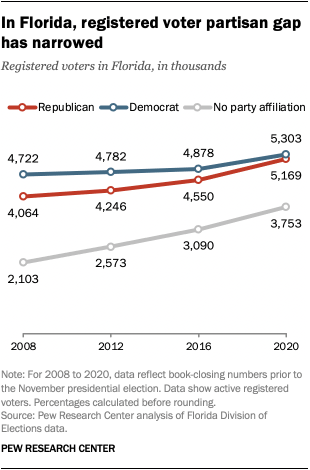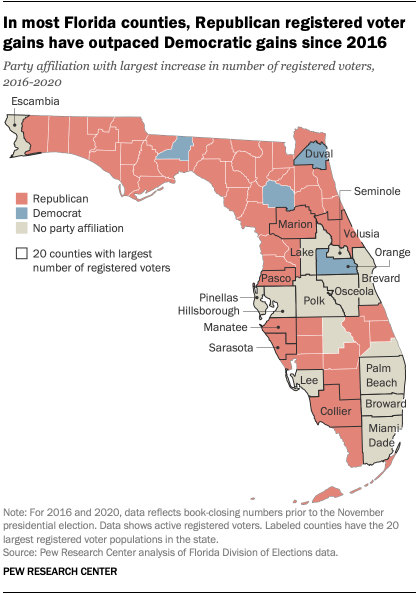What Percentage Of Florida Is Registered To Vote

More Floridians have registered to vote as Republicans than Democrats since the 2016 presidential elections, continuing a trend seen in previous presidential cycles and sharply narrowing the Democratic Party's advantage, according to a Pew Inquiry Center analysis of Florida land government data.
There currently are v.30 one thousand thousand registered Democrats and 5.17 million registered Republicans in the state – an edge of well-nigh 134,000 voters in favor of the Democrats. But the size of that margin has fallen from 327,000 in 2016 and 658,000 in 2008.
Democrats and Republicans now make upwards like shares of Florida's registered voters (37% and 36%, respectively), compared with 26% who have no party affiliation. In 2008, the Democratic share of voters was 6 percent points higher than that of Republicans (42% vs. 36%).
For this study, we analyzed the number of people registered to vote in Florida, including their distribution by party amalgamation and county of residence, based on information from the Florida Division of Elections.
There has been greater growth in the number of Floridians registered to vote as Republicans than equally Democrats since 2016. The number of Republican voters has risen by virtually 619,000, compared with an increase of 426,000 voters among Democrats. Nonetheless, the biggest increment during this flow has been amongst those who are registered with no party (+663,000).
While the unaffiliated make upwardly 26% of Florida's registered voters in 2020, relatively few voters bandage a ballot for third-political party presidential candidates in the state's elections. In 2016, Donald Trump narrowly beat Hillary Clinton in Florida, 49% vs. 48%, with third-party candidates winning 3% of the vote.
A perennial battlefield land in presidential elections, Florida has added 1.six million registered voters since the 2016 ballot, which is substantially more than the two previous presidential election cycles (929,000 between 2012 and 2016; 687,000 betwixt 2008 and 2012). These figures are every bit of Florida's "book closing" date on Oct. half-dozen and represent final voter registration figures for the Nov. 3 full general election.
When it comes to those eligible to annals as voters in Florida, demographics have shifted in recent decades as the number of Hispanic eligible voters has grown faster than other groups. In addition, the state has one of the largest immigrant eligible voter populations in the nation. (Eligible voters are not the same as registered voters. Eligible voters are adult U.S. citizens, simply non all eligible voters have registered to vote.)

In 49 of the state'south 67 counties, the increment in Republican registered voters since 2016 exceeded that of Democratic and unaffiliated registered voters.
All the same, in a majority of counties with big registered voter populations (i.e., counties with the twenty largest registered voter populations), the biggest increase has been amid those who are registered with no party affiliation. For example, in Miami-Dade, Broward, Palm Beach and Hillsborough – counties with the 4 largest registered voter populations, accounting for 33% of the state'due south registered voters – more people have registered with no party affiliation than equally Republicans or Democrats since 2016.
Luis Noe-Bustamante is a inquiry annotator who studies race and ethnicity, Hispanic trends and migration/immigration at Pew Research Center.
What Percentage Of Florida Is Registered To Vote,
Source: https://www.pewresearch.org/fact-tank/2020/10/20/democrats-advantage-over-republicans-among-florida-registered-voters-has-shrunk-since-2016/
Posted by: lynchthouthe1935.blogspot.com


0 Response to "What Percentage Of Florida Is Registered To Vote"
Post a Comment